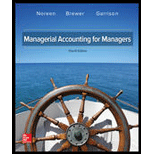
1.
Introduction:
Break-even point:
Break-even point is defined as the volume of production where the total cost is equal to the total sales revenue generated thereby resulting in a no-
To calculate: The variable expenses per unit.
2.
Introduction:
Break-even point:
Break-even point is defined as the volume of production where the total cost is equal to the total sales revenue generated thereby resulting in a no-profit and no loss situation. At the break-even point, the contribution earned is sufficient to cover the costs, whereas if the contribution is less than the break-even point then it is a loss and if it is more, then it is a profit.
To calculate: The break-even point in unit sales and dollar sales.
3.
Introduction:
Break-even point:
Break-even point is defined as the volume of production where the total cost is equal to the total sales revenue generated thereby resulting in a no-profit and no loss situation. At the break-even point, the contribution earned is sufficient to cover the costs, whereas if the contribution is less than the break-even point then it is a loss and if it is more, then it is a profit.
To calculate: The required amount of unit sales and dollar sales is required to achieve a target profit of $60000 per year.
4.
Introduction:
Break-even point:
Break-even point is defined as the volume of production where the total cost is equal to the total sales revenue generated thereby resulting in a no-profit and no loss situation. At the break-even point, the contribution earned is sufficient to cover the costs, whereas if the contribution is less than the break-even point then it is a loss and if it is more, then it is a profit.
To calculate: Company’s new break-even point in unit sales and in dollar sales upon assuming that if it uses a more efficient shipper and able to reduce variable expenses by $4 per unit. The dollar sales that is required to attain a target profit of $60000.
Want to see the full answer?
Check out a sample textbook solution
Chapter 3 Solutions
Managerial Accounting for Managers
- What is the main purpose of a cash flow statement?a) To report profits and lossesb) To show changes in equityc) To report cash inflows and outflowsd) To show the company's assetsneed helparrow_forwardWhat was the variable cost of goods soldarrow_forwardEagles Manufacturing uses the declining balance method of depreciation. They purchased a machine for $160,000 with an estimated salvage value of $20,000 and a useful life of 5 years. Using a declining balance rate of 30%, calculate the depreciation expense for the second year of the machine's use.arrow_forward
- What is the main purpose of a cash flow statement?a) To report profits and lossesb) To show changes in equityc) To report cash inflows and outflowsd) To show the company's assetsarrow_forwardI need help with this general accounting question using the proper accounting approach.arrow_forwardI am looking for a step-by-step explanation of this financial accounting problem with correct standards.arrow_forward
- Which method of inventory valuation assumes that the earliest goods purchased are sold first?a) FIFOb) LIFOc) Weighted Averaged) Specific Identificationneed help!arrow_forwardPlease provide the solution to this general accounting question using proper accounting principles.arrow_forwardWhich method of inventory valuation assumes that the earliest goods purchased are sold first?a) FIFOb) LIFOc) Weighted Averaged) Specific Identificationdont use aiarrow_forward

 AccountingAccountingISBN:9781337272094Author:WARREN, Carl S., Reeve, James M., Duchac, Jonathan E.Publisher:Cengage Learning,
AccountingAccountingISBN:9781337272094Author:WARREN, Carl S., Reeve, James M., Duchac, Jonathan E.Publisher:Cengage Learning, Accounting Information SystemsAccountingISBN:9781337619202Author:Hall, James A.Publisher:Cengage Learning,
Accounting Information SystemsAccountingISBN:9781337619202Author:Hall, James A.Publisher:Cengage Learning, Horngren's Cost Accounting: A Managerial Emphasis...AccountingISBN:9780134475585Author:Srikant M. Datar, Madhav V. RajanPublisher:PEARSON
Horngren's Cost Accounting: A Managerial Emphasis...AccountingISBN:9780134475585Author:Srikant M. Datar, Madhav V. RajanPublisher:PEARSON Intermediate AccountingAccountingISBN:9781259722660Author:J. David Spiceland, Mark W. Nelson, Wayne M ThomasPublisher:McGraw-Hill Education
Intermediate AccountingAccountingISBN:9781259722660Author:J. David Spiceland, Mark W. Nelson, Wayne M ThomasPublisher:McGraw-Hill Education Financial and Managerial AccountingAccountingISBN:9781259726705Author:John J Wild, Ken W. Shaw, Barbara Chiappetta Fundamental Accounting PrinciplesPublisher:McGraw-Hill Education
Financial and Managerial AccountingAccountingISBN:9781259726705Author:John J Wild, Ken W. Shaw, Barbara Chiappetta Fundamental Accounting PrinciplesPublisher:McGraw-Hill Education





